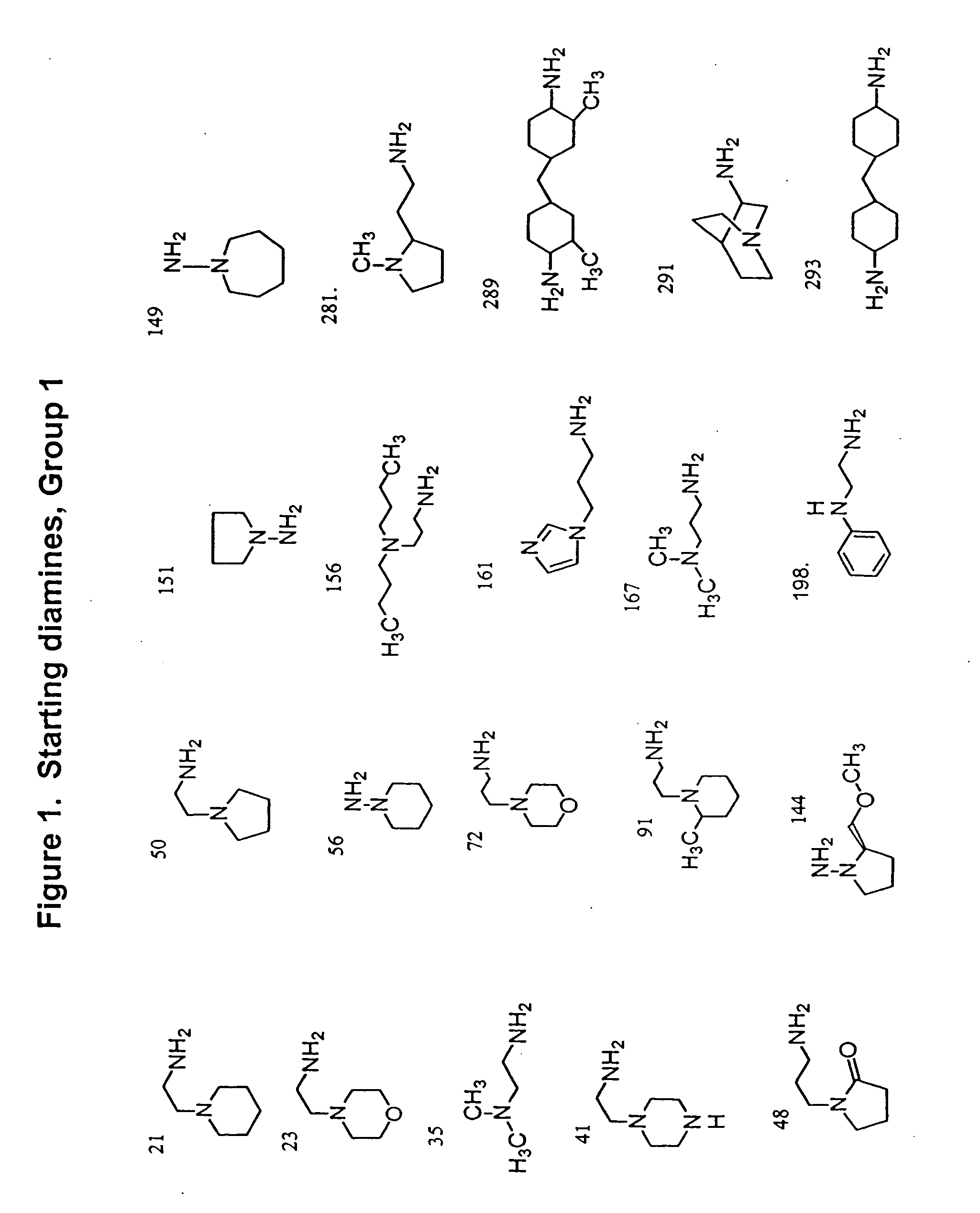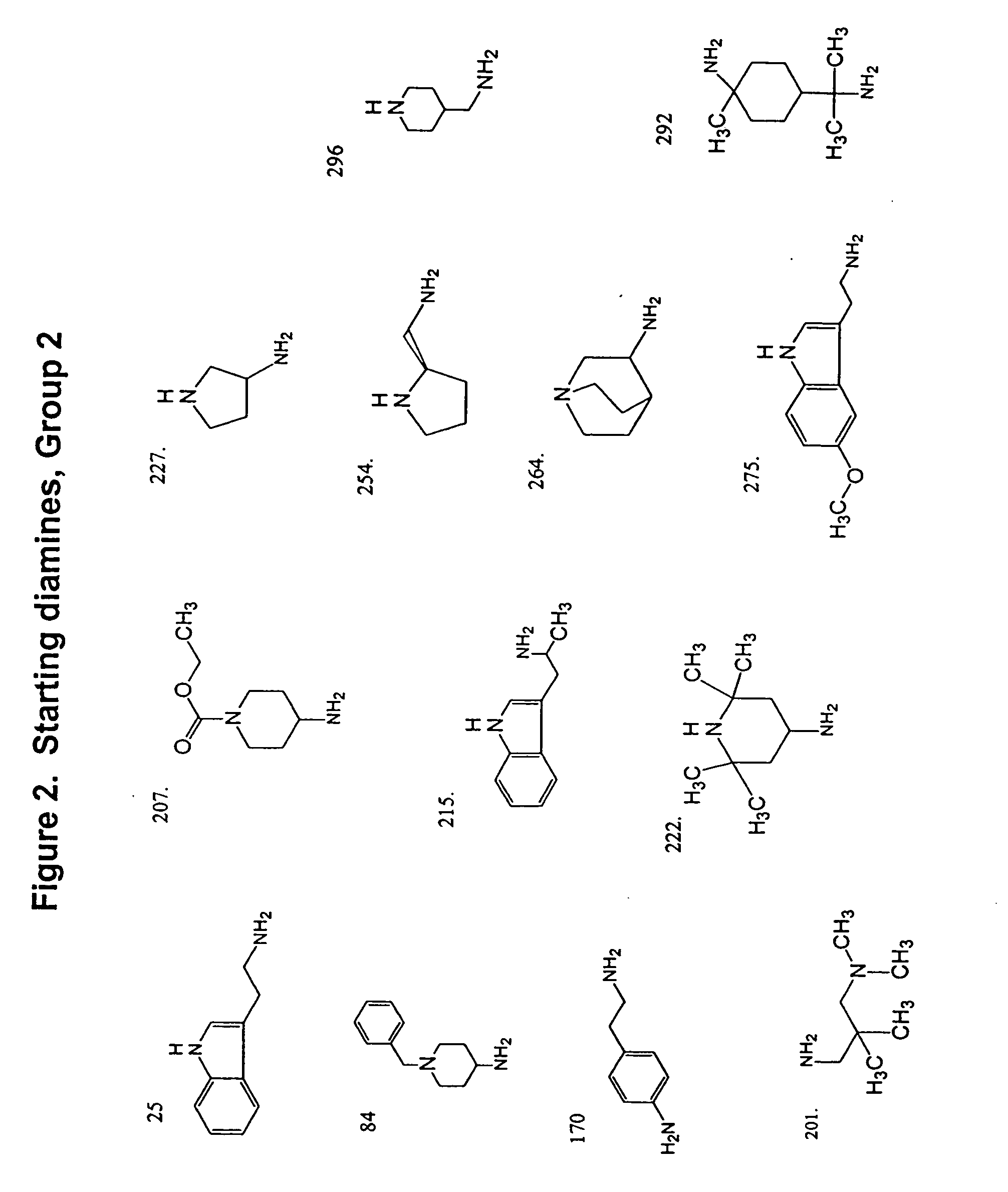Methods and compositions comprising diamines as new anti-tubercular therapeutics
a technology of anti-tuberculosis and diamine, which is applied in the field of new anti-tuberculosis compositions and methods for treating infectious agents, can solve the problems of overwhelming, disease in immunocompromised patients, and the leading cause of death of tuberculosis, so as to improve the anti-mycobacterial activity and improve the anti-tuberculosis activity
- Summary
- Abstract
- Description
- Claims
- Application Information
AI Technical Summary
Benefits of technology
Problems solved by technology
Method used
Image
Examples
example i
[0117] The following methods and protocols were generally used for synthesis and analysis of the novel diamine compositions of the present invention.
Preparation of the Library: General Methods
[0118] All reagents were purchased from Sigma-Aldrich (St. Louis, Mo., USA). (Polystyrylmethyl)trimethylammonium cyanoborohydride was obtained from NovaBiochem (Darmstadt, Germany). Solvents 1,2-dichloroethane (DCE), dichloromethane, and methanol were purchased from Aldrich and used as received. Solution phase syntheses were performed using combinatorial chemistry equipment (Whatman Polyfiltronics (Rockland, Mass., USA) and Robbins Scientific, (Sunnyvale, Calif., USA)). Evaporation of the solvents was done using SpeedVac AES (Thermo Electron Corporation, Massachussettes, USA). Mass spectra data were obtained by Electrospray Ionization technique on Perkin Elmer / Sciex, API-300, TQMS (Wellesley, Mass.) with an autosampler.
Generating the Library / General Synthetic Procedure
[0119] Sixty commerc...
example 2
[0150] The following methods and protocols were generally used for the in vitro analysis of the novel diamine compositions of the present invention.
Methods. In vitro Testing.
[0151] Cytotoxicity The Vero cell line (ATCC CCL-8 1) was seeded overnight at 5×104 cells per well in 96-well plates at 37° C. and 5% CO2 in EMEM with essential amino acids and glutamine (BioFluids) supplemented with 10% heat-inactivated fetal bovine serum (FBS). Cells were exposed to dilutions of experimental and control drugs in triplicate for 72 hr, with each compound at a range of concentrations from 15-200 μM. Chlorpromazine (Sigma) was run as a control at the same concentrations. CellTiter 96 AQueous Assay (Promega) was used for determination of Vero cell viability. Briefly, a solution of MTS salt (3-(4,5-dimethylthiazol-2-yl)-5-(3-carboxymethoxyphenyl)-2-(4-sulfophenyl)-2H-tetrazolium) and phenazine methosulfate was added to each well and plates were incubated for 2 hr at 37° ...
example 3
[0153] Two homopiperazines SQ775 and SQ780 and one piperazine compound SQ786 (see FIG. 21), were tested for mycobacterial activity in mice using two models, and proved to be efficacious against Mycobacterium tuberculosis in vivo.
In Vivo Studies
[0154]Mycobacterial inoculum: An aliquot of a frozen stock of M. tuberculosis H37Rv Pasteur was thawed and added to 5 ml 7H9 broth medium supplemented with 0.2% glycerol, albumin dextrose complex (ADC) and 0.05% Tween 80, and incubated 1 wk at 37° C. One (1) ml was then added into 25 ml fresh medium (the 2nd passage) during wk 2. The culture was washed twice with PBS and 0.05% Tween 80, re-suspended in PBS with 0.5% BSA and 0.05% Tween 80, and aliquots were frozen at −80° C. To determine viable Colony-forming Units (CFU) of the frozen culture, an aliquot was thawed and 10-fold dilutions were plated on agar 7H9 and incubated at 37° C. CFU were determined 20 d later.
[0155] Mice: Female C57BL / 6 mice, 8 wk old, were pu...
PUM
 Login to View More
Login to View More Abstract
Description
Claims
Application Information
 Login to View More
Login to View More - R&D
- Intellectual Property
- Life Sciences
- Materials
- Tech Scout
- Unparalleled Data Quality
- Higher Quality Content
- 60% Fewer Hallucinations
Browse by: Latest US Patents, China's latest patents, Technical Efficacy Thesaurus, Application Domain, Technology Topic, Popular Technical Reports.
© 2025 PatSnap. All rights reserved.Legal|Privacy policy|Modern Slavery Act Transparency Statement|Sitemap|About US| Contact US: help@patsnap.com



